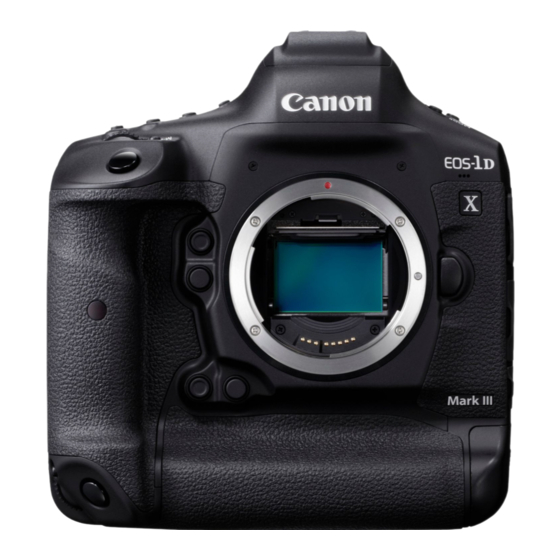
Canon EOS-1D Mark III Additional Functions
Hide thumbs
Also See for EOS-1D Mark III:
- Instruction manual (212 pages) ,
- User manual (63 pages) ,
- Product manual (39 pages)
Table of Contents
Advertisement
Quick Links
Custom Functions:
C.Fn I:
Exposure
C.Fn I-1: Exposure increments: speeds, apertures, and exposure compensation
1
I-1-0—
⁄
-stop increments for apertures, shutter speeds, and exposure compensation
3
I-1-1 — 1-stop increments when setting exposure,
1
I-1-2 —
⁄
-stop increments when setting exposure,
2
This function allows users to select
1
⁄
-stops for exposure compensation. For example, with C.Fn I-1-1, a photographer shooting in Av mode can quickly dial in f/8.0
2
using full-stops and then use exposure compensation in
exposure compensation.
C.Fn I-2: Full-stop or
I-2-0 — ISO set in
I-2-1 — ISO set in full stop increments
This function offers the option for selecting ISO in full-stop increments such as 100, then 200, then 400. Or the ISO can be adjusted
in tighter 1/3-stop increments such as 100–125–160–200. The ability to set ISO in
ideal for photographers who are used to using films rated at ISO 160, or for those who need slightly more light sensitivity and want
to maintain lower digital noise. Full-stop ISO increments can be handy for very rapid changes, especially for users who like to switch
ISO settings frequently.
C.Fn I-3: ISO Speed Range Selection
I-3 — Choices are: Disable, Enable, Register (select highest and lowest ISO)
The camera's default range of available ISOs is 100~3200. This function allows the user to either expand the available range or
shrink it, to suit their needs and the situation. Use this setting to make available ISO 6400 (H) and/or ISO 50 (L). Once a new ISO
range is "registered", you can apply it at any time by choosing "Enable". To return to the 100~3200 default, choose "Disable".
C.Fn I-4: Automatic canceling of Auto Exposure Bracketing
I-4-0 — On
I-4-1 — Off
Auto Exposure Bracketing is normally turned off when the camera has been powered down and then back on again, or when the
card or lens is removed. If your photography involves frequent bracketing and do not want the AEB to be cleared when the camera
is powered down or when the card and/or lens is removed, activate C.Fn I-4-1. Note that Auto Bracketing is always cancelled if an
EOS speedlite is connected and turned on, regardless of this Custom Function's setting.
1
1
⁄
-stop,
⁄
3
2
1
⁄
-stop ISO Speed setting increments
3
1
⁄
stop increments
3
EOS-1D Mark III
1
⁄
-stop exposure compensation
3
1
⁄
-stop increments when setting exposure compensation
2
-stop, or 1-stop increments when setting speeds and/or apertures, and
1
⁄
-stop increments. The default setting is
3
1
⁄
-stop for both exposure and
3
1
⁄
-stop increments has several advantages:
3
1
⁄
-stop or
3
Advertisement
Table of Contents

Subscribe to Our Youtube Channel
Summary of Contents for Canon EOS-1D Mark III
- Page 1 Custom Functions: EOS-1D Mark III C.Fn I: Exposure C.Fn I-1: Exposure increments: speeds, apertures, and exposure compensation I-1-0— ⁄ -stop increments for apertures, shutter speeds, and exposure compensation I-1-1 — 1-stop increments when setting exposure, ⁄ -stop exposure compensation I-1-2 —...
- Page 2 EOS-1D Mark III Exposure Custom Functions C.Fn I-5: Auto Exposure Bracketing sequence I-5-0 — First shot normal, second shot under, third shot over I-5-1 — First shot under, second shot normal, third shot over I-5-2 — First shot over, second shot normal, third shot under For use with Auto Exposure Bracketing this function sets up your desired shooting sequence.
- Page 3 EOS-1D Mark III Exposure Custom Functions C.Fn I-9: Select which exposure modes are available I-9 — Choices are: Disable, Enable, Register This function lets you decide what exposure modes are available from the Mode Selection button. By default, all the camera’s shoot- ing modes —...
- Page 4 II-2-1 — On Despite Canon’s unparalleled high ISO performance, this function reduces some of the chromatic noise that can occur when shooting at high ISO speeds. At low ISO speeds, this function will further reduce shadow area noise — especially if the image is lightened afterward in the computer —...
- Page 5 II-5-0 — 2nd-curtain sync. (Flash fires at the end of a long exposure) This Custom Function is strictly for Canon EOS speedlites which do not have a sync switch on the flash unit, such as the now-discon- tinued Speedlite 420EX or the previous ML-3 ring lite. When shooting with long shutter speeds, this function will fire the flash at the end of the long exposure as opposed to the beginning.
- Page 6 EOS-1D Mark III Image / Flash / Display Custom Functions C.Fn II-8: LCD Panel Illumination during Bulb exposures II-8-0 — Off II-8-1 — On during Bulb Enable this Custom Function for Bulb shooting in low light situations. With C.Fn II-8-1 active, if you have the LCD information panels illuminated at the beginning of the Bulb exposure they will stay illuminated.















Need help?
Do you have a question about the EOS-1D Mark III and is the answer not in the manual?
Questions and answers